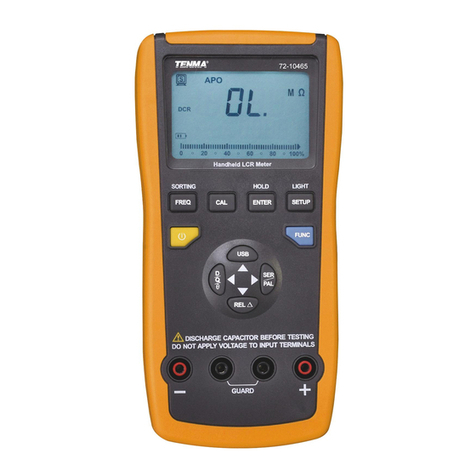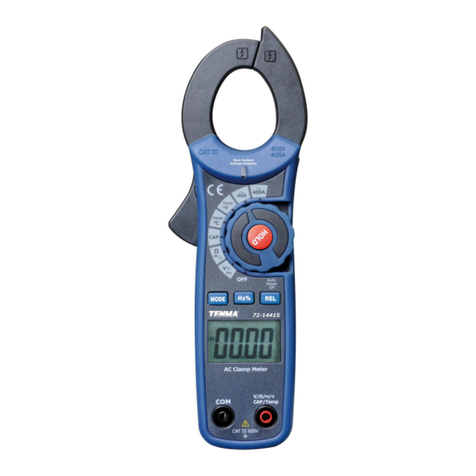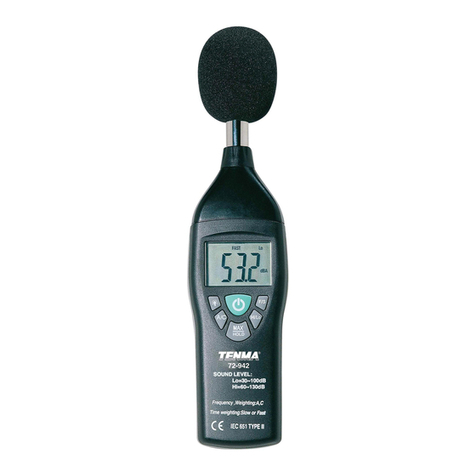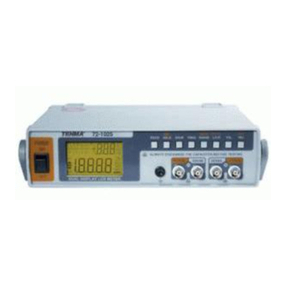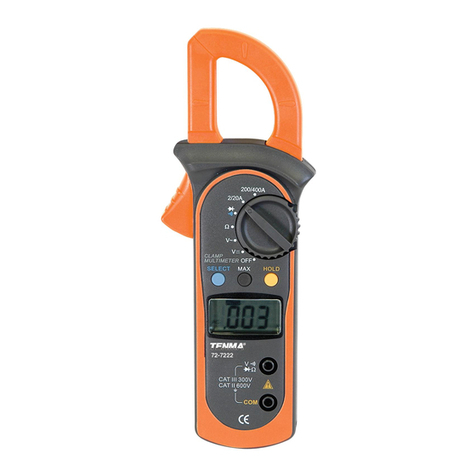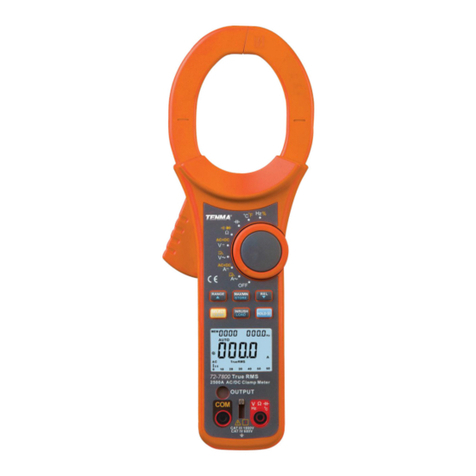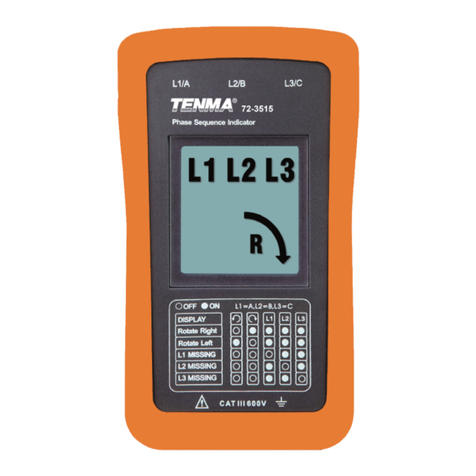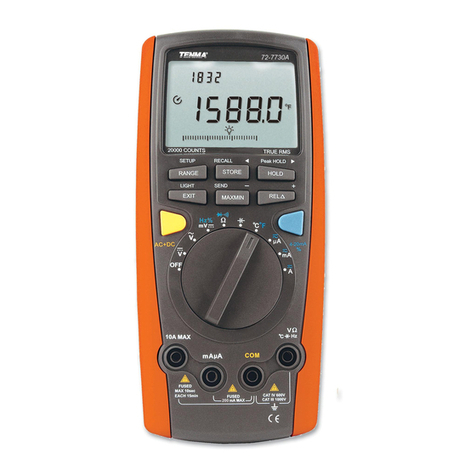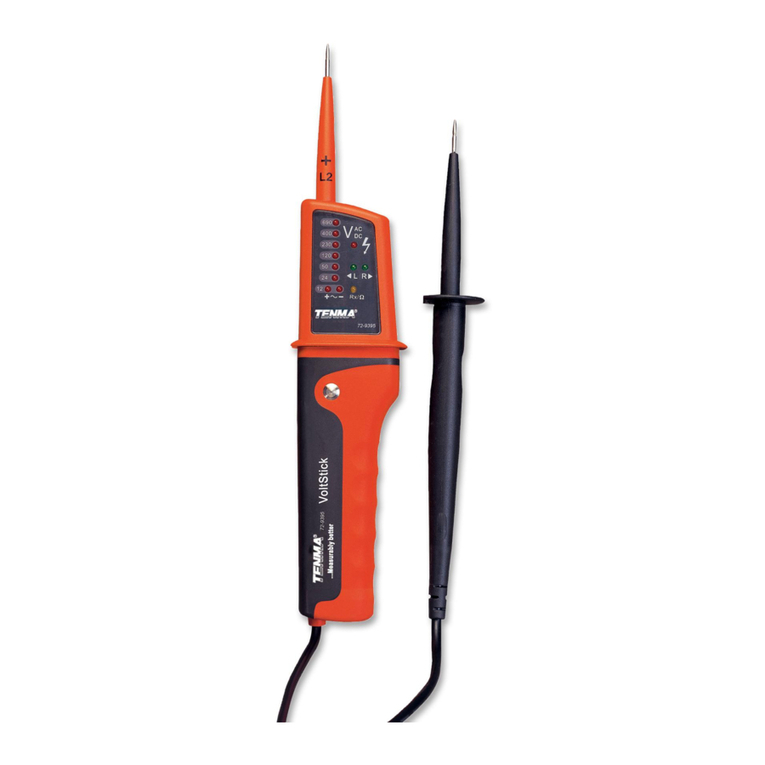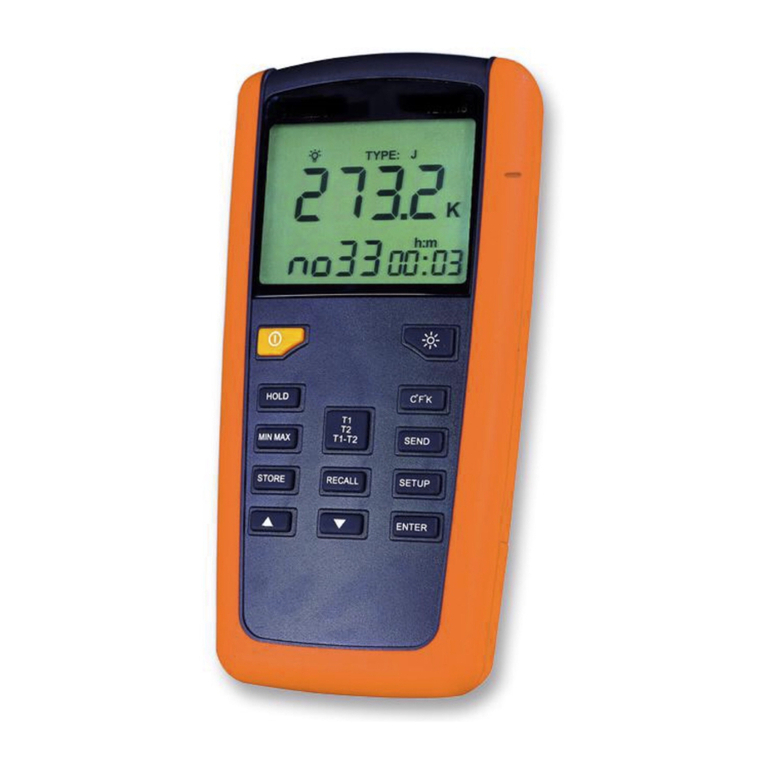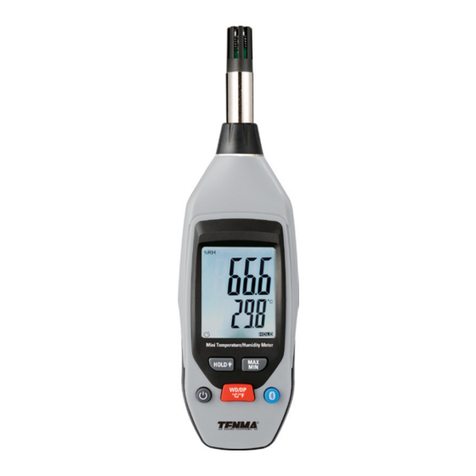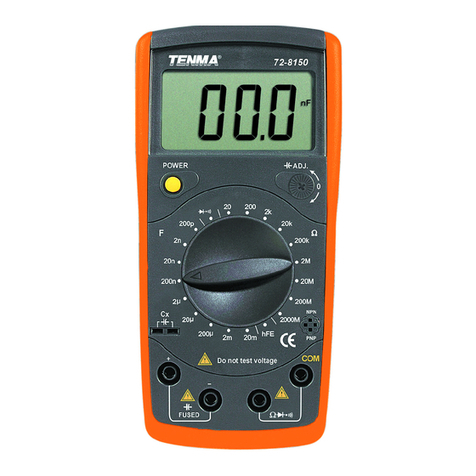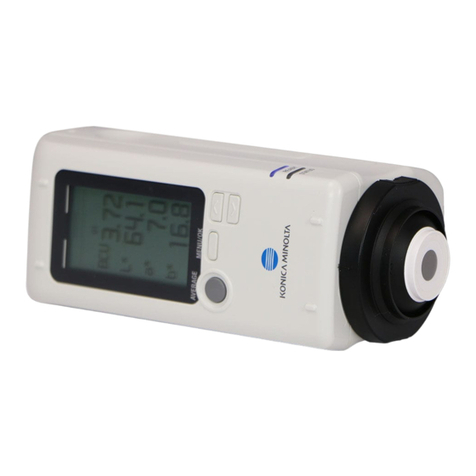
www.element14.com
www.farnell.com
www.newark.com
www.cpc.co.uk
Page <7> V1.006/03/19
For Continuity tests, if the resistance is < 150:, a tone will sound.
Capacitance Measurements
WARNING: To avoid electric shock, disconnect power to the unit under test and
discharge all capacitors before taking any capacitance measurements. Remove the
batteries and unplug the line cords.
1. Set the rotary function switch to the :•))) CAP position.
2. Insert the black test lead banana plug into the negative (COM) jack.
Insert the red test lead banana plug into the positive (V) jack.
3. Touch the test leads to the capacitor to be tested.
4. Read the capacitance value in the display
Frequency or % duty cycle measurements
1. Set the rotary function switch to the “VDC/AC,Hz” position.
2. Insert the black lead banana plug into the negative COM jack and the red test lead
banana plug into the positive V jack.
3. Select Hz or % duty with the Hz/% button.
4. Touch the test probe tips to the circuit under test.
5. Read the frequency on the display.
Temperature Measurements
WARNING: To avoid electric shock, disconnect both test probes from any source of
voltage before making a temperature measurement.
1. Set the function switch to ć.
2. Insert the Temperature Probe into the negative (COM) and the V jacks, making sure to
observe the correct polarity.
3. Touch the Temperature Probe head to the part whose temperature you wish to
measure. Keep the probe touching the part under test until the reading stabilizes (about 30
seconds).
4. Read the temperature in the display. The digital reading will indicate the proper decimal
point and value.
WARNING: To avoid electric shock, be sure the thermocouple has been removed before ch
anging to another measurement function
Non-Contact AC Voltage Measurements
1. Touch the probe tip to the hot conductor or insert into the hot side of the electrical outlet.
2. If AC voltage is present, the detector light will illuminate.
NOTE: The conductors in electrical cord sets are often twisted. For best results, rub the probe tip
along a length of the cord to assure placing the tip in close proximity to the live conductor.
WARNING: Risk of Electrocution. Before use,
always test the Voltage Detector on a known live
circuit to verify proper operation
NOTE: The detector is designed with high sensitivity. Static electricity or other sources of energy
may randomly trip the sensor. This is normal operation
MODE BUTTON
To select DC/ACV,OHM/ Diode/Continuity/CAP,
Data Hold Button
To freeze the LCD meter reading, press the data hold button. The data hold button is
located on the left side of the meter (top button). While data hold is active, the HOLD
display icon appears on the LCD. Press the data hold button again to return to normal
operation.
REL BUTTON
For DCA and Capacitance Zero & Offset adjustment.
RANGE BUTTON
When the meter is first turned on, it automatically goes into AutoRanging. This automatically selects the
best range for the measurements being made and is generally the best mode for most measurements.
For measurement situations requiring that a range be manually selected, perform the following:
1. Press the RANGE button. The “Auto Range” display indicator will turn off, The “Manual Range”
display indicator will turn on
2. Press the RANGE button to step through the available ranges until you select the range you want.
3. Press and hold the RANGE button for 2 seconds to
exit the ManualRanging mode and return to AutoRanging.
Battery Replacement
1. Remove the one rear Phillips head screw
2. Open the battery compartment
3. Replace the Requires One 9V battery
4. Re-assemble the meter
NOTE: The detector is designed with high sensitivity. Static electricity or other sources of energy
may randomly trip the sensor. This is normal operation
MODE BUTTON
To select DC/ACV,OHM/ Diode/Continuity/CAP,
Data Hold Button
To freeze the LCD meter reading, press the data hold button. The data hold button is
located on the left side of the meter (top button). While data hold is active, the HOLD
display icon appears on the LCD. Press the data hold button again to return to normal
operation.
REL BUTTON
For DCA and Capacitance Zero & Offset adjustment.
RANGE BUTTON
When the meter is first turned on, it automatically goes into AutoRanging. This automatically selects the
best range for the measurements being made and is generally the best mode for most measurements.
For measurement situations requiring that a range be manually selected, perform the following:
1. Press the RANGE button. The “Auto Range” display indicator will turn off, The “Manual Range”
display indicator will turn on
2. Press the RANGE button to step through the available ranges until you select the range you want.
3. Press and hold the RANGE button for 2 seconds to
exit the ManualRanging mode and return to AutoRanging.
Battery Replacement
1. Remove the one rear Phillips head screw
2. Open the battery compartment
3. Replace the Requires One 9V battery
NOTE: The detector is designed with high sensitivity. Static electricity or other sources of energy
may randomly trip the sensor. This is normal operation
MODE BUTTON
To select DC/ACV,OHM/ Diode/Continuity/CAP,
Data Hold Button
To freeze the LCD meter reading, press the data hold button. The data hold button is
located on the left side of the meter (top button). While data hold is active, the HOLD
display icon appears on the LCD. Press the data hold button again to return to normal
operation.
REL BUTTON
For DCA and Capacitance Zero & Offset adjustment.
RANGE BUTTON
When the meter is first turned on, it automatically goes into AutoRanging. This automatically selects the
best range for the measurements being made and is generally the best mode for most measurements.
For measurement situations requiring that a range be manually selected, perform the following:
1. Press the RANGE button. The “Auto Range” display indicator will turn off, The “Manual Range”
display indicator will turn on
2. Press the RANGE button to step through the available ranges until you select the range you want.
3. Press and hold the RANGE button for 2 seconds to
exit the ManualRanging mode and return to AutoRanging.
Battery Replacement
1. Remove the one rear Phillips head screw
2. Open the battery compartment
3. Replace the Requires One 9V battery
4. Re-assemble the meter
NOTE: The detector is designed with high sensitivity. Static electricity or other sources of energy
may randomly trip the sensor. This is normal operation
MODE BUTTON
To select DC/ACV,OHM/ Diode/Continuity/CAP,
Data Hold Button
To freeze the LCD meter reading, press the data hold button. The data hold button is
located on the left side of the meter (top button). While data hold is active, the HOLD
display icon appears on the LCD. Press the data hold button again to return to normal
operation.
REL BUTTON
For DCA and Capacitance Zero & Offset adjustment.
RANGE BUTTON
When the meter is first turned on, it automatically goes into AutoRanging. This automatically selects the
best range for the measurements being made and is generally the best mode for most measurements.
For measurement situations requiring that a range be manually selected, perform the following:
1. Press the RANGE button. The “Auto Range” display indicator will turn off, The “Manual Range”
display indicator will turn on
2. Press the RANGE button to step through the available ranges until you select the range you want.
3. Press and hold the RANGE button for 2 seconds to
exit the ManualRanging mode and return to AutoRanging.
Battery Replacement
1. Remove the one rear Phillips head screw
2. Open the battery compartment
3. Replace the Requires One 9V battery
4. Re-assemble the meter
NOTE: The detector is designed with high sensitivity. Static electricity or other sources of energy
may randomly trip the sensor. This is normal operation
MODE BUTTON
To select DC/ACV,OHM/ Diode/Continuity/CAP,
Data Hold Button
To freeze the LCD meter reading, press the data hold button. The data hold button is
located on the left side of the meter (top button). While data hold is active, the HOLD
display icon appears on the LCD. Press the data hold button again to return to normal
operation.
REL BUTTON
For DCA and Capacitance Zero & Offset adjustment.
RANGE BUTTON
When the meter is first turned on, it automatically goes into AutoRanging. This automatically selects the
best range for the measurements being made and is generally the best mode for most measurements.
For measurement situations requiring that a range be manually selected, perform the following:
1. Press the RANGE button. The “Auto Range” display indicator will turn off, The “Manual Range”
display indicator will turn on
2. Press the RANGE button to step through the available ranges until you select the range you want.
3. Press and hold the RANGE button for 2 seconds to
exit the ManualRanging mode and return to AutoRanging.
Battery Replacement
1. Remove the one rear Phillips head screw
2. Open the battery compartment
3. Replace the Requires One 9V battery
4. Re-assemble the meter
Important Notice : This data sheet and its contents (the “Information”) belong to the members of the Premier Farnell group of companies (the “Group”) or are licensed to it. No licence is granted
for the use of it other than for information purposes in connection with the products to which it relates. No licence of any intellectual property rights is granted. The Information is subject to change
without notice and replaces all data sheets previously supplied. The Information supplied is believed to be accurate but the Group assumes no responsibility for its accuracy or completeness, any
error in or omission from it or for any use made of it. Users of this data sheet should check for themselves the Information and the suitability of the products for their purpose and not make any
assumptions based on information included or omitted. Liability for loss or damage resulting from any reliance on the Information or use of it (including liability resulting from negligence or where the
Group was aware of the possibility of such loss or damage arising) is excluded. This will not operate to limit or restrict the Group’s liability for death or personal injury resulting from its negligence.
Tenma is the registered trademark of the Group. © Premier Farnell Limited 2016.

